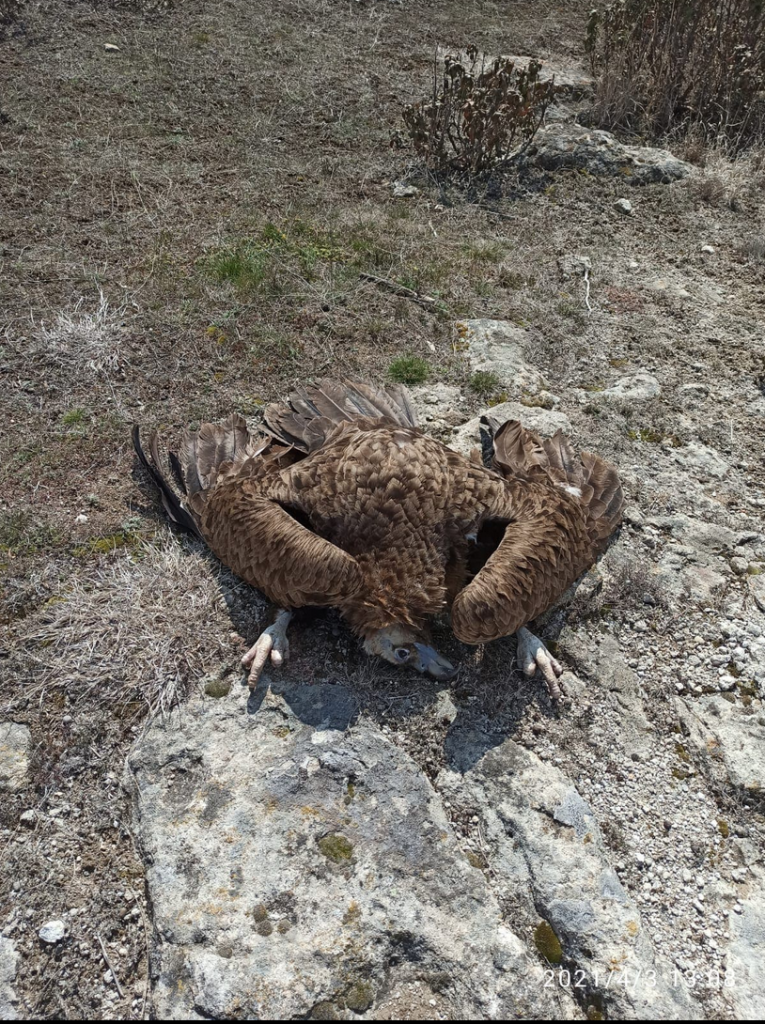
Late last week, a citizen in Turkey encountered a shocking sight — 7 Cinereous Vultures lying lifeless at Üçlerkayası Keçili in western central Turkey, near the Turkmenbaba Mountains, which is one of the well-known breeding areas for this species in the country. To make things worse, since most of the dead vultures affected were adults and this incident took place during the breeding period, the local population lost birds that were either starting to breed or about to lay eggs. What most likely killed these birds is poisoning, an illegal, unselective and damaging practice considered the most significant threat to vultures worldwide.
Investigation and impact of suspected poisoning incident

© Associate Professor Emine Hesna Kandır 
© Associate Professor Emine Hesna Kandır 
© Associate Professor Emine Hesna Kandır
A member of the public discovered the birds and called the competent authorities, DKMP 5. Bölge, swiftly after. Experts suspect that a poisoning incident lies behind this tragedy, based on the birds’ body postures and the fact that they were all found dead in close proximity to each other. However, specific examinations are necessary to confirm the cause of death. A team from Afyon Kocatepe University Wildlife Rescue and Rehabilitation Center (AKÜREM) collected the carcasses and subsequently performed a post-mortem analysis. Four of the birds were females, while 3 were males. Furthermore, Associate Professor Emine Hesna Kandır, the centre’s Director, also collected samples from their stomachs, livers and kidneys, and sent them to Etlik Veterinary Control Central Research Institute in Ankara to perform proper toxicological analysis.
Sadly, this incident caused adverse effects. The Cinereous Vulture breeding population in Turkey is estimated to comprise 80-200 pairs, meaning that this dramatic incident has probably affected between 2 to 9% of the national breeding population.
The Vulture Conservation Foundation (VCF) has already written to the Turkish authorities, offering help to further diagnose and investigate this case. It is important that authorities try to determine the driver of the poisoning incident, and if any suspects are identified, to take appropriate legal and criminal action. According to Turkish legislation, it is illegal to kill and/or poison protected species, with the penalty rising to up to 3 years in prison.
The threat of poisoning
Poison – usually put out to kill carnivores, not vultures, who are collateral victims of this illegal practice, is the main threat to vultures worldwide, as it was clearly identified in the Vulture Multi-species Action Plan (Vulture MsAP) – a global strategic blueprint identifying priorities and actions to conserve 15 species of old world vultures, endorsed by the Convention for Migratory Species and co-developed by the VCF. The VCF is particularly active in fighting this threat and is implementing several projects across Europe, such as BalkanDetox LIFE, to tackle illegal wildlife poisoning head-on.
Cinereous Vultures in Europe

While the Cinereous Vulture population in Western Europe is increasing — it has recolonized Portugal, been successfully introduced in France, and has increased significantly in Spain — the situation further east remains more fragile. In the Balkans, the species only breeds in a small colony in Greece where poisoning recently killed nesting birds, and is now being reintroduced in Bulgaria – where nesting attempts are now taking place for the first time in almost 30 years. It then occurs from Turkey eastern wards, but the trends for these populations are poorly known. Three of our Cinereous Vultures tagged in Bulgaria are currently in Turkey – you can follow their movements on our online public maps. Fortunately, none of these were affected by this latest poisoning incident.





